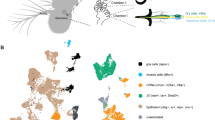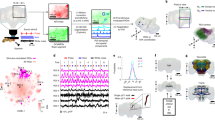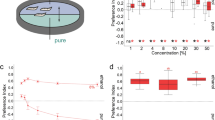Abstract
Hearing is an important sensory modality for most animals to detect sound signals as they mate, look for food or fend off prey. Despite its critical role in numerous innate behaviors, relatively little is known about how the sensory information regarding the movement of air particles is detected, processed and integrated in the brain. Drosophila melanogaster, with a rather simple nervous system and the large variety of molecular and genetic tools available for its study, is an ideal model organism for dissecting the mechanisms underlying sound sensing. Here we describe assays to measure sound responses of flies behaviorally. Although this method was originally developed for mutant screening, it can also be combined with recent genetic techniques to analyze functions of the identified neural circuits by silencing or activating select sets of neurons. This assay requires ∼15 min for an experiment and 1.5 h for subsequent analyses.
This is a preview of subscription content, access via your institution
Access options
Subscribe to this journal
Receive 12 print issues and online access
$259.00 per year
only $21.58 per issue
Buy this article
- Purchase on Springer Link
- Instant access to full article PDF
Prices may be subject to local taxes which are calculated during checkout


Similar content being viewed by others
References
Kamikouchi, A. et al. The neural basis of Drosophila gravity-sensing and hearing. Nature 458, 165–171 (2009).
Tauber, E. & Eberl, D.F. Acoustic communication in Drosophila . Behav. Processes 64, 197–210 (2003).
Kamikouchi, A., Shimada, T. & Ito, K. Comprehensive classification of the auditory sensory projections in the brain of the fruit fly Drosophila melanogaster . J. Comp. Neurol. 499, 317–356 (2006).
Yorozu, S. et al. Distinct sensory representations of wind and near-field sound in the Drosophila brain. Nature 458, 201–205 (2009).
Todi, S.V., Sharma, Y. & Eberl, D.F. Anatomical and molecular design of the Drosophila antenna as a flagellar auditory organ. Microsc. Res. Tech. 63, 388–389 (2004).
Kernan, M.J. Mechanotransduction and auditory transduction in Drosophila . Pflugers Arch. 454, 703–720 (2007).
Greenspan, R.J. & Ferveur, J.F. Courtship in Drosophila . Annu. Rev. Genet. 34, 205–232 (2000).
Ritchie, M.G., Halsey, E.J. & Gleason, J.M. Drosophila song as a species-specific mating signal and the behavioural importance of Kyriacou & Hall cycles in D. melanogaster song. Anim. Behav. 58, 649–657 (1999).
Talyn, B.C. & Dowse, H.B. The role of courtship song in sexual selection and species recognition by female Drosophila melanogaster . Anim. Behav. 68, 1165–1180 (2004).
Clyne, J.D. & Miesenböck, G. Sex-specific control and tuning of the pattern generator for courtship song in Drosophila . Cell 133, 354–363 (2008).
Ejima, A. & Griffith, L.C. Courtship initiation is stimulated by acoustic signals in Drosophila melanogaster . PLoS ONE 3, e3246 (2008).
Crossley, S.A., Bennet-Clark, H.C. & Evert., H.T. Courtship song components affect male and female Drosophila differently. Anim. Behav. 50, 827–839 (1995).
Eberl, D.F., Duyk, G.M. & Perrimon, N. A genetic screen for mutations that disrupt an auditory response in Drosophila melanogaster . Proc. Natl. Acad. Sci. USA 94, 14837–14842 (1997).
Göpfert, M.C., Humphris, A.D., Albert, J.T., Robert, D. & Hendrich, O. Power gain exhibited by motile mechanosensory neurons in Drosophila ears. Proc. Natl. Acad. Sci. USA 102, 325–330 (2005).
Eberl, D.F., Hardy, R.W. & Kernan, M.J. Genetically similar transduction mechanisms for touch and hearing in Drosophila . J. Neurosci. 20, 5981–5988 (2000).
Nadrowski, B., Albert, J.T. & Göpfert, M.C. Transducer-based force generation explains active process in Drosophila hearing. Curr. Biol. 18, 1365–1372 (2008).
Kitamoto, T. Conditional modification of behavior in Drosophila by targeted expression of a temperature-sensitive shibire allele in defined neurons. J. Neurobiol. 47, 81–92 (2001).
McGuire, S.E., Le, P.T., Osborn, A.J., Matsumoto, K. & Davis, R.L. Spatiotemporal rescue of memory dysfunction in Drosophila . Science 302, 1765–1768 (2003).
Sweeney, S.T., Broadie, K., Keane, J., Niemann, H. & O'Kane, C.J. Targeted expression of tetanus toxin light chain in Drosophila specifically eliminates synaptic transmission and causes behavioral defects. Neuron 14, 341–351 (1995).
Inagaki, H.K., Kamikouchi, A. & Ito, K. Methods for quantifying simple gravity sensing in Drosophila melanogaster . Nat. Protoc. 5, 20–25 (2010).
Acknowledgements
We thank D.F. Eberl for original courtship song data. This work was supported by the Alexander von Humboldt Foundation and the Japan Society for the Promotion of Science (to A.K.) and the Human Frontier Science Program Organization, BIRD/Japan Science and Technology Agency and the Japan Society for the Promotion of Science (to K.I.).
Author information
Authors and Affiliations
Contributions
H.K.I., A.K. and K.I. designed experiments; H.K.I. performed experiments; H.K.I., A.K. and K.I. wrote the paper; and K.I. supervised the work. All authors discussed the concepts and results, and commented on the paper.
Corresponding author
Supplementary information
Supplementary Audio 1
Synthesized courtship song for stimulating male chaining behaviour (WAV; 9.2 MB). The original data are kindly provided by Dr. D.F. Eberl13. Note that the synthesized courtship song starts after 5-min of silent period. The sound intensity is constant; the volume of the sound amplifier should be turned up every 30 sec to increase loudness during experiment (See EQUIPMENT SETUP).
Supplementary Fig. 1
Drawing of the acoustic behaviour chamber (scale 1/1).
Rights and permissions
About this article
Cite this article
Inagaki, H., Kamikouchi, A. & Ito, K. Protocol for quantifying sound-sensing ability of Drosophila melanogaster. Nat Protoc 5, 26–30 (2010). https://doi.org/10.1038/nprot.2009.206
Published:
Issue Date:
DOI: https://doi.org/10.1038/nprot.2009.206
This article is cited by
-
Homeostatic maintenance and age-related functional decline in the Drosophila ear
Scientific Reports (2020)
-
Oral administration of graphene oxide nano-sheets induces oxidative stress, genotoxicity, and behavioral teratogenicity in Drosophila melanogaster
Environmental Science and Pollution Research (2019)
Comments
By submitting a comment you agree to abide by our Terms and Community Guidelines. If you find something abusive or that does not comply with our terms or guidelines please flag it as inappropriate.



